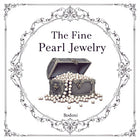Pearl Education
TAHITIAN PEARLS
Commonly known as black pearls around the world, the pearls in Tahiti are indigenous to the remote lagoons of French Polynesia in the South Pacific where the black -lipped oyster is found, a mollusk that secretes a black nacreous substance. The average size ranges 8-16 mm in diameter with shapes in round, pear and even circled. The beauty of Tahitian Black Pearls lies in the nature of its rich color based on the black key tone, among which is the most admired peacock green, dark blue and they change its metal-like luster as being turned around, unmatched is the other dyed pearls, this explains the rareness and the most prestigious status that has crowned Tahitian Black Pearls the Queen of Pearls.
AKOYA PEARLS
They are seawater cultured pearls of Japanese origin along the southern coasts and are formed by Akoya oysters. Akoya pearl characterizes in its perfect round shape, rich luster in pink and silvery white, size from 5.5-8.5mm in diameters. Only white, golden, cream and silver gray are known as natural colors of Akoya pearls. But technology today allows the appearances of many other colors such as black, blue, brown and etc.
SOUTH SEA WHITE PEARLS
Also referred to as Silvery White Pearls, Australia and Indonesia cultivate the South Sea Pearls from the wild Pinctada Maxima, the largest mother of pearl in the world, thus the world's largest South Sea Pearls are produced, sizing from 9-18mm in diameter. Like black pearls, its silvery white luster is all natural with no treatment done to the original color. Due to the limited quality produced, South Sea Pearls have become extremely rare and precious.
SOUTH SEA GOLDEN PEARLS
The Philippines and Indonesia are home to the South Sea Gold Pearls, formed by gold oysters. Sizing from 9-16mm in diameter. The majority of the pearls display champagne color, the minority gold, a true indicator in value.
LUSTER
Pearl luster is the quality and quantity of light that reflects from both surface and under surface of the pearl nacre. The degree of luster is determined by the amount of nacre deposited in the pearl during its formation, which is also related to the duration of the pearl development with in the oyster. In other words, the more nacre it has in pearl, the more light refletion it will have, and hence the higher luster and brilliance the pearl will have. Pearls with higher luster generally value more than pearls with lower luster.
The GIA Pearl Grading for Luster:
Excellent - Reflection are bright,sharp and distinct
Good - Reflections are bright but not sharp, and they are slightly hazy around the edges
Fair - Reflections are weak, hazy and blurred
Poor - Reflections are dim and diffused
SURFACE
According to the FTC, a pearl can never be graded as "flawless", but the degree or perentage of inclusion can be measured. The appearance of the pearl surface is one of the most critical characteristics in determining its value. Ideally, the pearl surface should be clean, smooth and shiny. However, flaws such as spots, bumps or indentations are also acceptable. Yet, the more "flawless" the surface of a pearl is the higher values.
SURFACE
The GIA Pearl Grading for Surface:
Clean - Pearls are almost blemish-free or contain minute surface characteristics that are very difficult to see
Lightly Blemished - Pearls show minor surface irregularities
Moderately Blemished - Pearls show noticeable surface characteristics
Heavily Blemished - Pearls shows obvious surface irregularities that might affect durability
NACRE
Pearl Nacre is a substance secreted by mollusks (oysters) over the nucleus during the formation of a pearl. It is yet lightweight and transparent, which allows light to pass through its surface and creates glow (luster) to the pearl. Nacre is invisible to human's eye but it significantly affects the beauty of pearl. Thicker nacre usually requires more time for a pearl to be cultured and therefore makes the pearl more durable.
The GIA Pearl Grading for Nacre:
Very Thick - At least 0.5 mm on all the pearls
Thick - At least 0.5 mm on most pearls
Medium - 0.35 - 0.5 mm on most most pearls
Thin - 0.25 - 0.35 mm on most pearls
Very Thin - 0.25 mm or less on most pearls

